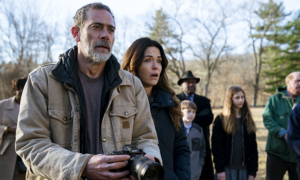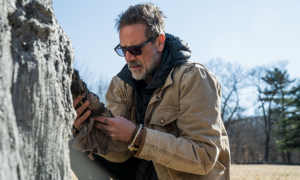Based on James Herbert’s Shrine, The Unholy tells the story of a young hearing-impaired girl Alice (Cricket Brown, pictured above) who is visited by the Virgin Mary and can suddenly hear, speak and heal the sick.
As people flock to witness her miracles, a disgraced journalist, Gerry (Jeffrey Dean Morgan) hoping to revive his career, visits a small New England town to investigate. Soon terrifying events begin to happen in the little town and he starts questioning if these miracles are the works of the Virgin Mary or something much more sinister.
We spoke to The Unholy writer and director Evan Spiliotopoulos taking on his first directing role and his love of James Herbert…
How did it all begin for you to write and direct The Unholy?
I was a big James Herbert fan. James Herbert in the Eighties competed with Stephen King on the bestseller lists. I’m Greek, and James Herbert’s books were translated into Greek, so we got him over there as well.
I had read pretty much everything by the time Shrine came around in 1983. I was already a film buff, so as soon as I read it, I was like, ‘boy, this is a movie’ because it was a great combination of a classic supernatural thriller like The Exorcist with classic journalism thriller like All The President’s Men. I love movies that meld genres, because it’s something different, it’s more exciting. So as I entered the film business as a screenwriter and my career kind of ascended, I would always go around to studios saying: “Who will adopt this orphan child for me?!” [haha].
Finally Screen Gems in 2018 agreed, except they hit me with a curveball and wanted me to direct it. They felt that because I had lived with a book for so long and made a name as a writer, that it was my time. It was my opportunity to direct. So I of course thought ‘oh you crazy people, I’m going to destroy this thing, I’m going to ruin it’, and then they brought Sam Raimi in. Sam was the adult in the room, and I, of course, as everybody else, absolutely loved his movies, and it turned out that he’s a very approachable, brilliant guy who can talk to you one-on-one. So I figured, okay, I will continue on this mad adventure until Sam kicks me off, but he didn’t, and here we are!
The Unholy is based on James Herbert’s Shrine, why change the name?
I will blatantly dump that on marketing! It’s funny because I actually just posted on Facebook – we have six titles right now. We started with Shrine, we are The Unholy (that’s the movie we went out with in English language territories), we are Sanctuary Of Shadows in Portuguese speaking territories, The Sacred Evil in Italy, The Devil’s Chapel in France, and Pray For Us in Spanish language territories!
But The Unholy, I’ll be blunt about why the choice was – people in America don’t know what a shrine is. They did a focus test, and a lot of people didn’t know what a shrine is. In fact, I read one answer where they thought it was the beads that Catholics pray with. They thought the rosary was a shrine. One reasonable answer though was that people knew what a shrine was but didn’t immediately associate it with a horror movie. Now that’s important. So basically, the marketing department asked: ‘If you hear a title called Shrine, what do you think it is?’ and the smarter audiences said, ‘oh it’s a religious, faith-driven film’. The Unholy – boom horror movie, so that that’s the reason.
What really stood out to you in the book that you wanted to include in the film adaptation?
Here’s the crazy thing. The book was written in 1983. The term ‘fake news’ has really entered the zeitgeist in the last three or four years, and it is so incredibly topical [but] the heart of the book is about fake news. It was about, in the book’s case, the devil creating a false story. In the movie’s case, it’s about a corrupt journalist taking a fake story and running with it.
That’s something that we never wanted to lose sight of. That at the core, there was this character named Gerry Fenn, who had it all and lost it because he was greedy. Now he’s using this bizarre story to get himself back on top, and for two thirds of the movie, no matter what it cost. As bodies are dropping around him, he’s still thinking ‘okay, if I can only hold on to this!’.
It’s not until the last third when things get too far, that this man realises he has to destroy the story. The redemption arc of Gerry is totally what attracted Jeffrey [Dean Morgan], to the part and also what we wanted to preserve because great characters make great drama.

For a lot of the movie, Gerry is a bit of a jerk. How did you keep that balance of not making him too unlikeable?
We were lucky enough to have reference here. Billy Wilder in 1952 made a movie called Ace In The Hole (I believe, the European title is The Big Carnival) – Kirk Douglas plays a corrupt journalist who, in the aftermath of a mine cave-in in a small town, discovers there are still survivors. He’s the only one who knows where these people are trapped, and he won’t reveal it, because he wants to milk the story as long as possible.
The character is far darker than Gerry in our movie. The reason you go along with it is because he’s played by Kirk Douglas, and the reason you go along with Gerry is because he’s played by Jeffrey Dean Morgan. If you had an actor who was not fun, sexy charismatic and likable, you couldn’t get away with it.
This is a guy, in Jeffrey Dean’s case, who’s one of the great television villains in history who beats people’s brains out with a baseball bat with nails on him and you like him. So that’s the trick. The trick is, you’ve got to cast somebody who’s just charming as the devil.
Jeffrey and I had a very funny backstory actually. I hadn’t met him before but the previous home that I lived in for seven years, I bought from Jeffrey Dean! So when we did our first conference call I showed him my living room and went: ‘Jeffrey, do you know where I am right now?’ and he was like ‘that’s my house!’. So we knew we had the same taste basically.
A lot of casting in this movie was ‘it was meant to be’. For example, we had a wonderful actor for Father Hagen, who had to pull out due to scheduling conflicts. Because our movie’s a studio movie but at that budget level you’re borderline indie, so you’re not paying the ultimate price for a lot of your actors, and they have the ability to pull out.
Bill Sadler had auditioned, and I had seen his audition and been like, ‘if anything happens, he’s the guy’, and he was still available, so he stepped in. A lot of crazy things happen that way. He is the nicest man imaginable. He’s the guy who between takes will sit on the side and tell you great stories of his experiences. He was amazing.

This is your first time directing, how did you begin the process?
I had the pleasure and good fortune of being on several of the bigger budget, live-action movies. I started my career in animation primarily. In animation, you’re automatically always on the set because you’re in Disney Studios and they’re drawing around you but with live-action, I had the opportunity to watch the directors work for several films. As a result, I knew my way around the set, and I kind of knew what the director does, which in case there are people out there who don’t know, you do everything! There’s an image I want to put in your head, which is basically, I’m in my office in pre-production, and there is literally a line of people outside the door, who are waiting to ask you questions. The questions range from, ‘how does the makeup look?’ to ‘what vase do we put on the dining room table?’ to ‘Father Hagen, we have five options for his priestly garb’ (I always thought was black with a collar). They ask you everything, and there’s no time for bathroom breaks.
How did you find juggling all those elements?
In a normal world that would have been the challenging element, in our world it was COVID. We started filming in February of 2020, and you know what happened the month after that!
So, four weeks into our seven-week schedule, we stopped and we came home, we went into lockdown and we stayed in lockdown for five months.
I had the unique opportunity, I don’t know when any other directors had this chance, of taking the footage from the first half of production, and actually assembling it with my editor virtually, to see what we’d got, and see where we ere you needed to go. Then five months later, [we went back to] actually finishing the movie. But finishing it under rather difficult circumstances where now you have fewer hours, you’re not allowed extras indoors, everybody’s in basically hazmat suits because the actors who are mask-less are so vulnerable, and you’re moving slower. After every setup you’re hosing down the set with antiseptic spray so everything is taking time.
Now, memo to aspiring filmmakers, time is your big enemy in film! You’re constantly trying to make your day. If you don’t make your day, you’re going to go over budget over schedule and over budget.
Stephen Chbosky, who shared co-writing credit with me on Beauty And The Beast who’s a great director, he did The Perks of Being a Wallflower and Wonder, told me before I set off on this thing that the first two weeks of production, you’re sitting with the actors thinking what a great movie you’re making the rest of the production, you’re racing the clock just trying to get footage in the can!
So, yeah, I would not advise people directing a movie during a pandemic!
Duly noted! The Unholy is Available to Download & Keep, Rent on Digital and on Blu-Ray™ & DVD on 2 August. Pre-order here.
